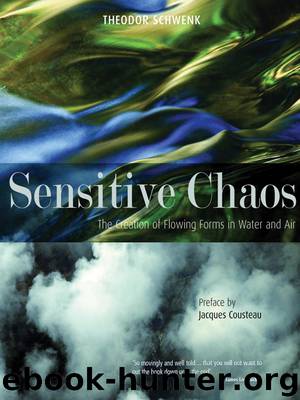Sensitive Chaos by Theodor Schwenk

Author:Theodor Schwenk
Language: eng
Format: epub
Publisher: Rudolf Steiner Press
Published: 2012-04-06T04:00:00+00:00
Three Characteristic Features of Water
Three characteristic features of water, forming together a complete picture, emerge from our considerations. Two of these are clear for all to see, the third is almost unknown, requiring very sensitive methods of observation. The first is the activity of water in all metabolic processes in the great organism of the earth and in each separate living creature. The second is its close connection with all rhythmical processes in time and space. The third comes to light in our observation of the sensitivity of boundary surfaces, indicating that water is a cosmic sense organ of the earth. All three functions— functions which are well known to us in the world of living organisms—form a whole.
Is it not as though water were itself an organism? Do we not see in water the threefold organism of man—an archetypal picture, though purely functional, of the metabolic, nerve-sense and rhythmic organizations?1 Perhaps these three characteristics of water form the basis of all living organisms, whose specialization goes in the direction of one or other of the three? Let us now consider the three characteristics in the light of this new question, commencing with water as a ‘substance’.
As all organisms consist chiefly of water, it is obvious that water is the primary and most essential element for all living processes. It refrains from taking on a form of its own, but fills out any form offered it and envelops any that dip into it. In their development many creatures, including man, climb out, as it were, from the water on to dry land. The human embryo, enveloped in the maternal organism and entirely floating in water, gradually creates the distinct form of its organs out of the liquid. In the second month it still consists almost entirely of water, and even in old age about 60 per cent of the human body is water. The first and very often the last food taken by a human being is liquid. It is only because water flows and dissolves substances that organisms—plant, animal and man— can take solid substance as nourishment at all. The whole process of breaking down and building up of substances within an organism is unthinkable without water; by far the greater proportion of chemical changes is dependent on water as a mediating and dissolving element. In its own nature, water does not commit itself in any way; chemically it is neutral and therefore has a multitude of possibilities for nearly all chemical changes.1
In metabolism, however, it is not merely a question of transformation of substances, but also of the accompanying heat processes; for these too, water is the basis. It is able to absorb not only large quantities of dissolved substances but also a great amount of heat and to transport it wherever it goes. The countries of northern Europe owe their mild climate to this fact; the Gulf Stream flowing past them brings the warmth of the tropics with which it is laden. It flows on into polar
Download
This site does not store any files on its server. We only index and link to content provided by other sites. Please contact the content providers to delete copyright contents if any and email us, we'll remove relevant links or contents immediately.
| Anthropology | Archaeology |
| Philosophy | Politics & Government |
| Social Sciences | Sociology |
| Women's Studies |
The remains of the day by Kazuo Ishiguro(8887)
Tools of Titans by Timothy Ferriss(8303)
Giovanni's Room by James Baldwin(7246)
The Black Swan by Nassim Nicholas Taleb(7054)
Inner Engineering: A Yogi's Guide to Joy by Sadhguru(6752)
The Way of Zen by Alan W. Watts(6547)
Asking the Right Questions: A Guide to Critical Thinking by M. Neil Browne & Stuart M. Keeley(5705)
The Power of Now: A Guide to Spiritual Enlightenment by Eckhart Tolle(5674)
The Six Wives Of Henry VIII (WOMEN IN HISTORY) by Fraser Antonia(5453)
Astrophysics for People in a Hurry by Neil DeGrasse Tyson(5150)
Housekeeping by Marilynne Robinson(4390)
12 Rules for Life by Jordan B. Peterson(4275)
Double Down (Diary of a Wimpy Kid Book 11) by Jeff Kinney(4239)
The Ethical Slut by Janet W. Hardy(4211)
Skin in the Game by Nassim Nicholas Taleb(4200)
Ikigai by Héctor García & Francesc Miralles(4169)
The Art of Happiness by The Dalai Lama(4089)
Skin in the Game: Hidden Asymmetries in Daily Life by Nassim Nicholas Taleb(3960)
Walking by Henry David Thoreau(3921)
